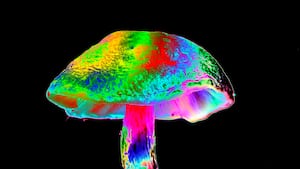American and European corporations have for centuries been bastardizing and profiting from the ceremonial plants and drugs used by Indigenous cultures in the Americas. The most notorious is tobacco, used for sacred purposes across different Indigenous groups like the Seminole and the Navajo for thousands of years in a form that would be unrecognizable to most of us. It was far more concentrated and much harder to inhale. But as Europeans colonized the Americas, they pushed Indigenous people off their land, making it harder to cultivate and use for their ceremonies.
Tobacco was removed from its ceremonial roots and uses, while retaining the branding of Indigenous cultures. “Over time, American companies developed lighter varieties of tobacco that, with the help of filters, could be inhaled into the lungs, leading to the health scourge that nicotine addiction causes worldwide,” Alberto Ribas-Casasayas a professor of Spanish and Latin American studies at Santa Clara University who specializes in the role of psychoactives in culture, particularly in Mexico and Southern Europe.
Tobacco is far from the only substance with forgotten Indigenous origins to be commodified. The production of cocoa, once considered sacred in Aztec culture, quickly came under control by colonial settlers in the 1500s and was a major driver of violent colonial expansion. Though cannabis didn’t originate in the Americas, it was first introduced to Indigenous people by settlers in the 1600s, and quickly became sacred to some tribes in Mexico who discovered its psychoactive effects. Fast forward to the 21st century, and we now see Western companies patent and sell cannabis seeds from plants traditionally grown in the global south back to those very same farmers. There is a recurring pattern of appropriating and profiting off Indigenous plants and drugs throughout history, said Ribas-Cassayas.
Now, history may be repeating itself in the emerging psychedelics space. The rise of psychedelic drugs as a potential way to treat mental health issues has given rise to a spate of startups which are using one arm to monopolize and patent substances, and the other arm to lobby policy makers against wholesale decriminalization of these drugs. The goal is to keep the sale and production of these drugs exclusive to private industry, while excluding Indigenous communities whose knowledge of these drugs can run far deeper.
“For a company to not acknowledge Indigenous people as the original holders or acknowledge the the historical trauma that European Americans have inflicted on indigenous people, but still use the medicine, there’s no excuse,”said Marlena Robbins, an Indigenous member of the Diné (Navajo) nation in Crystal, New Mexico, currently working as a student fellow at the University of California, Berkeley’s Center for the Science of Psychedelics.
The term “biopiracy” refers to the patenting or profiting of biological substances derived from plants or animals that have already been in use by a region’s Indigenous people for centuries or even millennia. Modern patent laws may directly or indirectly deprive indigenous cultures of psychedelics that they’ve used for thousands of years. “Psychedelic medicine today is a largely speculative field with a lot of (as yet unrealized) promise,” Ribas-Cassayas said. “A lot of actors have mobilized and are working hard at creating artificial barriers to access and rent-seeking procedures. Patents are just one particularly insidious way of achieving these ends.”
Take peyote—a spineless cactus that contains mescaline, a psychoactive substance that causes hallucinations, altered perception, and extreme emotions. It was criminalized across most states by 1930, after a long moral panic that blamed peyote for evil and violent behavior. The New York Times warned that peyote was part of the “Cult of Death” in 1923. “This has been a major factor leading to this plant’s endangerment today,” Ribas-Cassayas said. Prohibitionists used the law to stop consumption of peyote.
And yet, while peyote’s ceremonial use was criminalized and its plant population declined, its active ingredient continued to generate sales for the pharmaceutical giant Merck. The Austrian chemist Ernst Späth synthesized mescaline in a lab in 1919, and Merck marketed it. Creative people in particular were interested in experimenting with mescaline; in Europe, it was used recreationally by renowned authors and artists such as Aldous Huxley. While researchers ran clinical trials to study mescaline’s ability to treat psychiatric conditions, it fell out of favor as a cheaper, lab-synthesized hallucinogen called lysergic acid diethylamide (LSD) became available. In short, mescaline was criminalized for Indigenous populations while scientists attempted to develop it into a profitable drug. But mescaline became disposable to Merck when a cheaper alternative became available.
Peyote and mescaline are still considered controlled substances in the U.S., but as of 1996 usage federal permits their use for Indigenous ceremonies in most states. Some activists are pushing for full decriminalization for recreational use—but to the dismay of some Indigenous leaders, who argue widespread decriminalization would further endanger the plant and actually decrease availability. This could be especially true for the peyote cactus, which takes up to 15 years to grow and mature until it can be extracted.
And Indigenous groups are concerned that putting a price tag on these drugs will actually end up hurting the communities for whom these drugs hold special significance.
“Psychedelics being the new gold rush for a lot of these corporations is limiting access for those who need it most: for communities of color, for Indigenous people, for BIPOC communities, and making it financially inaccessible,” Robbins said. “It’s the new, hot, shiny toy that everybody wants to jump onto, and try to figure out how to make money off of it.”
Andrew Judge (Mkomose), an Anishanabe assistant professor at Algoma University in Canada who specializes in ethno-medicine and land-based learning (recognizing the connections between Indigenous people and their environment), agreed. “What you might have is somebody who experiences the power of these medicines and then just uses that to pursue or further their colonial exploits,” he told The Daily Beast, adding that the process of turning these compounds into medicine removes it from the connection and responsibility to the land where it grows.
This is part of the cycle of biopiracy that Judge described as a “violent colonial process”. Indigenous plants are criminalized, patented, sold without any Indigenous context, and then decades later legalized.
According to Judge, about 10 years ago he heard from an Anishinaabe elder on Wikwemikong Manitoulin Island who shared the knowledge of a certain plant medicine. That medicine was then taken by industry scientists—who then proceeded to patent and monetize it. “These kinds of stories are quite common,” he said. “A lot of indigenous knowledge makes up the basis of the current pharmacopeia used in modern medicine.” Judge wasn’t comfortable identifying the plant, or which industry scientists allegedly appropriated and profited off it. He added concerns that companies that do this may attempt to cause harm to the ecosystem as they attempt to control cultivation of the planet. “Because the money is wrapped up in the plant, they now want to destroy further access,” said Judge. He added that the Indigenous people who saw this happening were poor, wanted to be left alone, and didn’t have the means or knowledge to seek recourse.
Robbins believes that psychedelic ceremonies may help people heal from depression or anxiety, but they also play an important role for Indigenous people today who are dealing with their historic trauma. “There’s plenty of ancestral trauma that European-American lineages have inflicted upon Indigenous people,” she said. “Indigenous people are trying to heal from this intergenerational trauma of colonization, genocide and boarding school trauma that have occurred through Christianity, the United States government and the Spanish invasion.” This uncomfortable history, she argued, must be acknowledged when companies decide to work with psychedelics, and Indigenous people should be acknowledged as companies seek to work with natural compounds they’ve used for millennia.
It is widely recognized that pharmaceutical companies exploit the patent process. New York-based consumer group Initiative for Medicines, Access & Knowledge reported in September of 2022 that many top-earning drugmakers get a sprawling web of patents for making or using a drug, using these so-called patent thickets to stave off competition since other companies can’t access individual patents needed to make a similar drug. Amgen’s autoimmune-treating drug Embrel, for example, is enjoying three decades of exclusivity on the market because of a slew of patents.
But these issues may be further magnified in the psychedelic space. “Patent examiners do not have the resources they need to adequately examine patent applications to determine if they truly are novel and non-obvious inventions,” Graham Pechenik, a patent attorney at Calyx Law, which practices patent law within the psychedelic space, told The Daily Beast. If you want to patent a new drug, you need to prove in the application that no one else has ever presented the drug publicly. But Indigenous and historical use of drugs is seldom considered by attorneys when determining whether a drug is new or not. “Indigenous use is not recorded anywhere at all in a format that might be available to a patent examiner to see.”
And criminalization in modern times can still be deployed as a cudgel that provides extra protection to these patents. Ribas-Cassays believes it’s plausible that a company may patent a psychedelic drug while lobbying against legalization to prevent dangerous or irresponsible use, effectively restricting access in pursuit of profit. “I think it’s safe to be critical of psychedelic companies who are coming into fruition,” Robbins added.
This is more than just a far-fetched concern. One need look no further than American pharmaceutical companies lobbying to ban recreational cannabis use so the market for synthetic cannabinoids remains strong. In August of 2016, Insys Therapeutics donated $500,000 to Arizona’s anti-legalization efforts, with a spokesperson saying that legalization “fails to protect the safety of Arizona’s citizens, and particularly its children.” Reporting from The Intercept later that year showed that Insys’ leaders were not motivated by safety concerns, but because their “ability to generate revenue and our business prospects would be materially adversely affected.”
And Purdue Pharma, which has taken a big hit thanks to its role in fueling the opioid crisis, was one of the largest 2014 contributors to the Community Anti-Drug Coalition of America that has lobbied against legalization of marijuana.
The ability to patent quickly and lobby aggressively means companies can act as the gatekeepers to emerging markets, including for psychedelics. “The sort of central aspect of a patent application when it’s granted as a patent is it provides a monopoly,” Pechenik said, adding that monopolies allow them to extract more profit. “The companies that are successful in getting patents tend to be the winners in the field.” With so many companies capitalizing and profiting off of Indigenous drugs and plants, is there an ethical way to include their practices?
“I think that a psychedelic company can have indigenous reciprocity initiatives that help support the cross cultural relationship between indigenous nations to share in culture and knowledge, and trade medicine and ceremony,” Robbins said.
There is, in fact, one such company. This year, Journey Colab, a San Francisco-based company that wants to use psychedelics to treat addiction, filed a patent for the use of lab-made mescaline to treat alcohol abuse disorders. In December 2022, Journey Colab published a patent non-assertion pledge which promised not to sue Indigenous communities or practitioners using traditional forms of peyote or mescaline, even though they could technically sue for patent infringement. It is the first psychedelics company to make such a patent non-assertion pledge.









